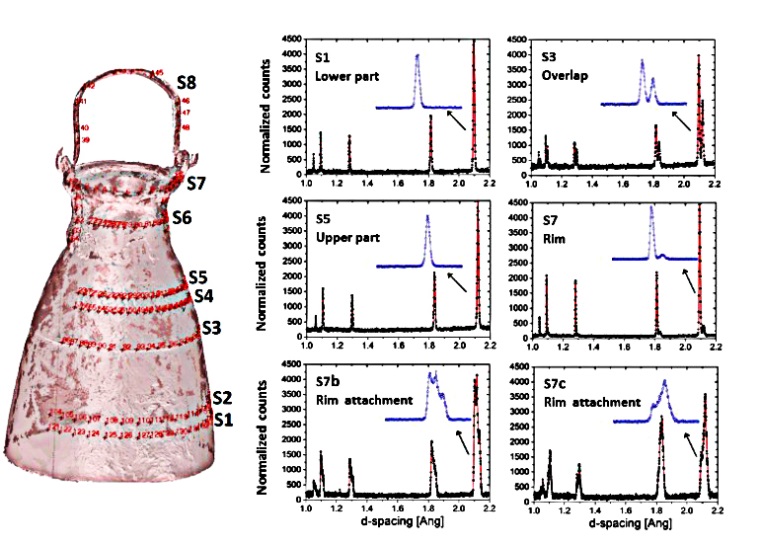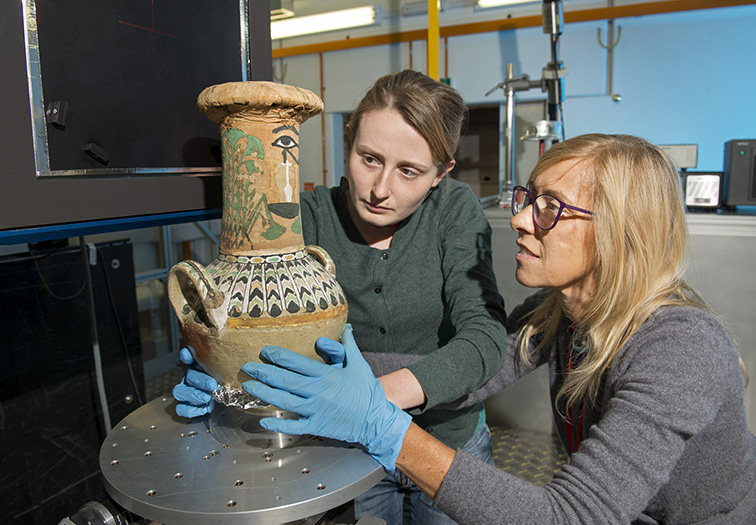In 1906, the archaeologist Ernesto Schiaparelli and the Inspector of Antiquities, Arthur Weigall, opened the door of the inner chamber of tomb TT8 located on the cliffs surrounding the ancient village of Deir el Medina in Egypt. Little did they know at the time that tomb TT8 was the burial and undisturbed resting place of an 18th Dynasty royal architect named Kha and his wife Merit. Within the tomb was what is now considered the richest and most complete non-royal burial assemblage ever found and housed in a museum outside of Egypt, dating back to the New Kingdom of 1425 – 1353 BC.
Now in 2018 - over 100 years since its discovery - an international collaboration of scientists have been using cutting-edge modern neutron technology to unravel secrets about the tomb and its contents.

|
Figure 1: Deir El-medina in Egypt as it is today. Image credit Didia
|
The team, led by the Museo Egizio in Turin, were on the hunt for the Seven Sacred Oils of Ancient Egypt, referenced in literature but never discovered. The two artefacts studied at ISIS were a sealed alabaster vase and a metallic situla, taken from a collection of grave goods found at the tomb of upper-class Ancient Egyptians Kha and Merit. The group, led by Guilia Festa from Centro Fermi and Dr Triestino Minniti from the ISIS Neutron & Muon Source, used IMAT to carry out Neutron Radiography (NR), Neutron Tomography (NT) and Prompt Gamma Activation Analysis (PGAA), whilst ENGIN-X provided further Neutron Diffraction (ND) measurements.

|
Figure 2: The statuette of the 18th dynasty Egyptian official Kha from Theban Tomb 8 in Upper Egypt. The tomb was discovered intact by Ernesto Schiaparelli in 1906. The funerary treasures are today located in the Egyptian Museum of Turin, Italy. (Image credit = Jean-Pierre Dalbera)
|
Figure 3 shows how Neutron Tomography (NT) and 3D volume rendering was used to image the content of the alabaster vase without unsealing it. These show the content of the vase is an almost homogeneous substance, which strongly attenuates the neutron beam. Furthermore, the images also unveil the presence of a truncated-cone plug under the linen sheet (Fig 3d). The internal content of the alabaster vase (dark red region on Fig 3d) showed an absorption coefficient matched to an organic compound such as a mixture of oils and wax. The prediction of the neutron linear attenuation coefficient came from a mixture of typical animal and vegetal organic compounds that scientists used for comparison purposes.

|
Figure 3: NT slices and 3D volume rendering of the alabaster vase (Fester et al, 2018).
|
Information regarding the composition of the situla - a type of elaborate bucket-shaped vessel usually with a handle on top - came from diffraction scans, see Figure 4.

|
Figure 4: Comparing the diffraction patterns from different parts of Kha and Merit's situla in the d-spacing range 1-2.2 Å. The bronze peak shape (111) is highlighted in the insect (Festa et al, 2018).
|
The experiment revealed that the lower part of this elaborate bucket-shaped vessel is composed of a low tin bronze with around 2% Tin (Sn) whilst the upper part is made of a 9% Tin bronze.
Combined data from ENGIN-X and IMAT provided details of the inner morphology, structure and elemental composition of both of the vases from Kha and Merit's grave. The sealed alabaster vase was found to contain organic material, along with an alabaster cone-shape plug covered with linen stripes. The situla, on the other hand, was discovered to be the product of two different alloys with two halves joined together by rivets.

|
Figure 5: Matilde Borla, Soprintendenza Archeologia Piemonte, Italy and Valentina Turina, Musco Egizio di Torino, adjusting an Egyptian vase mounted on the IMAT instrument at the ISIS Neutron & Muon Source.
|
The synergic combination of non-destructive and non-invasive neutron and gamma techniques allowed the team to create unprecedented morphological reconstructions of the inner parts of both the alabaster and the metallic vase. Evidence relating to their isotopic and phase composition provided by IMAT and ENGIN-X have together expanded our knowledge of the content of these vases and their functions. The team hope that the applied experimental methods used in their study will have a further impact across many disciplines including materials and environmental science, palaeontology and archaeology. Further analysis of alabaster, textiles and wood artefacts from the same TT8 grave is also currently taking place.
“By utilizing the unique capabilities of the new neutron imaging instrument IMAT and the consolidated capabilities of ENGIN-X we were able to non-invasively study these precious artefacts. The combine information from neutron imaging, diffraction and PGAA techniques have allowed to shed light on the halo of mystery around the Seven Sacred Oils of Ancient Egypt."
Dr Triestino Minniti, IMAT instrument scientist
Further information
The research was supported by CNR, within the CNR-STFC Agreement 2014-2020. The full publication is available to view in Angewandte Chemie.
For further information about the research, please contact Dr Triestino Minniti.
Find out more about our IMAT and ENGIN-X
Browse all our science highlights here.
